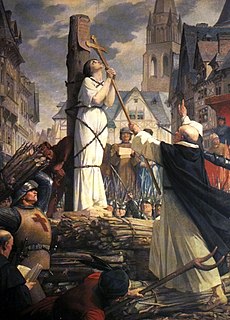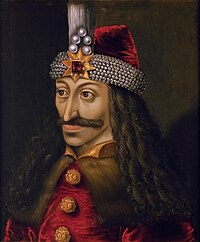
Mehmed II, commonly known as Mehmed the Conqueror, was an Ottoman sultan who ruled from August 1444 to September 1446, and then later from February 1451 to May 1481. In Mehmed II's first reign, he defeated the crusade led by John Hunyadi after the Hungarian incursions into his country broke the conditions of the truce Peace of Szeged. When Mehmed II ascended the throne again in 1451, he strengthened the Ottoman navy and made preparations to attack Constantinople. At the age of 21, he conquered Constantinople and brought an end to the Byzantine Empire.
Year 1436 (MCDXXXVI) was a leap year starting on Sunday of the Julian calendar.
The 1430s decade ran from January 1, 1430, to December 31, 1439.
The 1460s decade ran from January 1, 1460, to December 31, 1469.
The 1470s decade ran from January 1, 1470, to December 31, 1479.
The 1450s decade ran from January 1, 1450, to December 31, 1459.

Year 1431 (MCDXXXI) was a common year starting on Monday of the Julian calendar.
The 1440s decade ran from January 1, 1440, to December 31, 1449.
The 1420s decade ran from January 1, 1420, to December 31, 1429.
Year 1475 (MCDLXXV) was a common year starting on Sunday of the Julian calendar.
Year 1456 (MCDLVI) was a leap year starting on Thursday of the Julian calendar.
Year 1432 (MCDXXXII) was a leap year starting on Tuesday of the Julian calendar.
Radu III of Wallachia, commonly called Radu the Handsome or Radu the Fair, was the younger brother of Vlad III and Prince of the principality of Wallachia. They were both sons of Vlad II Dracul and his wife, Princess Cneajna of Moldavia. In addition to Vlad III, Radu also had two older siblings, Mircea II and Vlad Călugărul, both of whom would also briefly rule Wallachia.

Vlad II, also known as Vlad Dracul or Vlad the Dragon, was Voivode of Wallachia from 1436 to 1442, and again from 1443 to 1447. He is internationally known as the father of Vlad the Impaler, or Dracula. Born an illegitimate son of Mircea I of Wallachia, he spent his youth at the court of Sigismund of Luxembourg, who made him a member of the Order of the Dragon in 1431. Sigismund also recognized him as the lawful voivode of Wallachia, allowing him to settle in nearby Transylvania. Vlad could not assert his claim during the life of his half-brother, Alexander I Aldea, who acknowledged the suzerainty of the Ottoman Sultan, Murad II.

Vlad III, commonly known as Vlad the Impaler or Vlad Dracula, was Voivode of Wallachia three times between 1448 and his death in 1476/77. He is often considered one of the most important rulers in Wallachian history and a national hero of Romania.
Mircea II (1428–1447) was the Voivode, or prince, of Wallachia in 1442. He was the oldest son of Vlad II Dracul and brother of Vlad Țepeș and Radu the Handsome. He was the grandson of his namesake Mircea cel Bătrân.
Basarab IV cel Tânăr, also known as Țepeluș, son of Basarab II, and grandson of Dan II (1422-1431) was 4 times the voivode of the principality of Wallachia between 1474 and 1482: from Oct to Dec 1474, from Jan 1478 to June 1480, from Nov 1480 to before July 1481, and again from Aug 1481 to July 1482.

The Night Attack at Târgoviște was a battle fought between forces of Vlad III, Prince of Wallachia, and Sultan Mehmed II of the Ottoman Empire on Thursday, June 17, 1462. The battle started after Mehmed, who already had tense relations with Vlad, discovered his alliance with Hungary's king Matthias Corvinus and ordered his forces to ambush him. Vlad foiled the attack and invaded Bulgaria. In response, Mehmed raised a great army with the objective to conquer Wallachia and annex it to his empire. The two leaders fought a series of skirmishes, the most notable one being the Night Attack where Vlad attacked the Turkish camp in the night in an attempt to kill Mehmed. The assassination attempt failed and Mehmed marched to the Wallachian capital of Târgoviște, where he found a few men with cannons. After leaving the capital, Mehmed discovered 23,844 impaled Turks whom Vlad had killed during his invasion of Bulgaria. The number is mentioned by Vlad himself in a letter to Matthias Corvinus. The sultan and his troops then sailed to Brăila and burned it to the ground before retreating to Adrianople. Both sides claimed victory in the campaign and Mehmed's forces returned home with many captured slaves, horses, and cattle.

The Ottoman–Hungarian Wars were a series of battles between the Ottoman Empire and the medieval Kingdom of Hungary. Following the Byzantine Civil War, the Ottoman capture of Gallipoli, and the decisive Battle of Kosovo, the Ottoman Empire was poised to conquer the entirety of the Balkans and also sought and expressed desire to expand further north into Central Europe beginning with the Hungarian lands.
The 1400s ran from January 1, 1400, to December 31, 1409.






